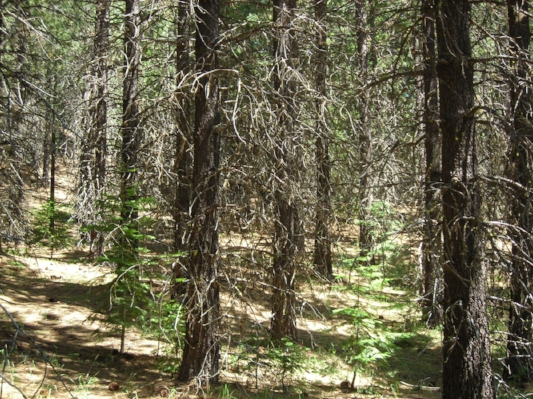Forest Restoration and Timber Byproducts
KS Wild supports thinning that restores forests that have been altered by past logging and fire exclusion. Thinning can produce by-products such as poles and small logs. Read on to learn more about where thinning can be a part of forest restoration efforts.
Thinning and Fire
Fire has shaped Klamath-Siskiyou forests for tens of thousands of years. The KS forests have a “mixed fire regime,” meaning that they experienced low, moderate and high severity fires depending on the weather, fuels, and other factors. Native Americans also burned forests to encourage the growth of useful plants, such as oaks and beargrass.
Since fire suppression has been effective - about 100 years - small trees that would have burned are now encroaching into many forests and meadows. Some scientists argue our forests are now vulnerable to uncharacteristic, higher severity wildfire. Habitats like groves of native oaks are vanishing due to encroachment of trees that result from a lack of fire.
Protecting Homes and Lives
People are increasingly settling further and further out into the forest-urban inter- face. Fires that were once a natural part of the basin now threaten communities and structures that have popped up in recent decades. In addition to restoring forests, treating high fire hazard areas and creating defensible space around these homes and communities has been a priority of the Oregon Department of Forestry, several municipalities and federal land managers.
Restoring Plantations
Logging has left indelible scars throughout the Klamath-Siskiyou's once bountiful forests. Large scale logging operations began in the early 1900s using railroads. By the 1950s, “clearcut” logging was common across the Pacific Northwest. But finally in the 1990s, growing awareness of forest ecology slowed the pace of clearcutting. As a result of this legacy, artificial tree “plantations” are widespread on public land in the region.
Recent scientific research shows that carefully thinning tree plantations can help restore these overly dense and unnatural forests. Research also show these plantations burn hotter than more natural forests. Thinning can help improve the habitat for wildlife and accelerate the development of old-growth forests. Ecologically based thinning projects can also produce timber from small trees that are in excess in the forest, taking pressure away from logging older forests.
Collaboration Can Work
The extreme complexity and variability of this region's forests make decisions about cutting trees very local. KS Wild has been a part of dozens of collaborative efforts focused on ecologically based thinning of small diameter trees in the Klamath-Siskiyou which help make those decisions. We partner with the Forest Service and BLM representatives, as well as sociologists, timber industry interests and others when possible and when forest restoration is driving the management decision, as opposed to timber production.
Getting Fire Back On The Ground
The ultimate goal of forest management in the Klamath-Siskiyou should be to get fire back on the ground under appropriate conditions. In some areas and weather conditions, wildfire can carry out its historic role in the ecology of forests. While this is not be possible near communities, there are many areas where wildfire use is appropriate under the right weather and fuels conditions. KS Wild generally support the use of prescribed fire to restore forests to more resilient conditions.
Fire burns in the understory of a forest on public lands.
Lomakatsi Restoration Project is thinning many overly dense forests throughout the region.
KS Wild works with land managers and communities to enhance forest health.




